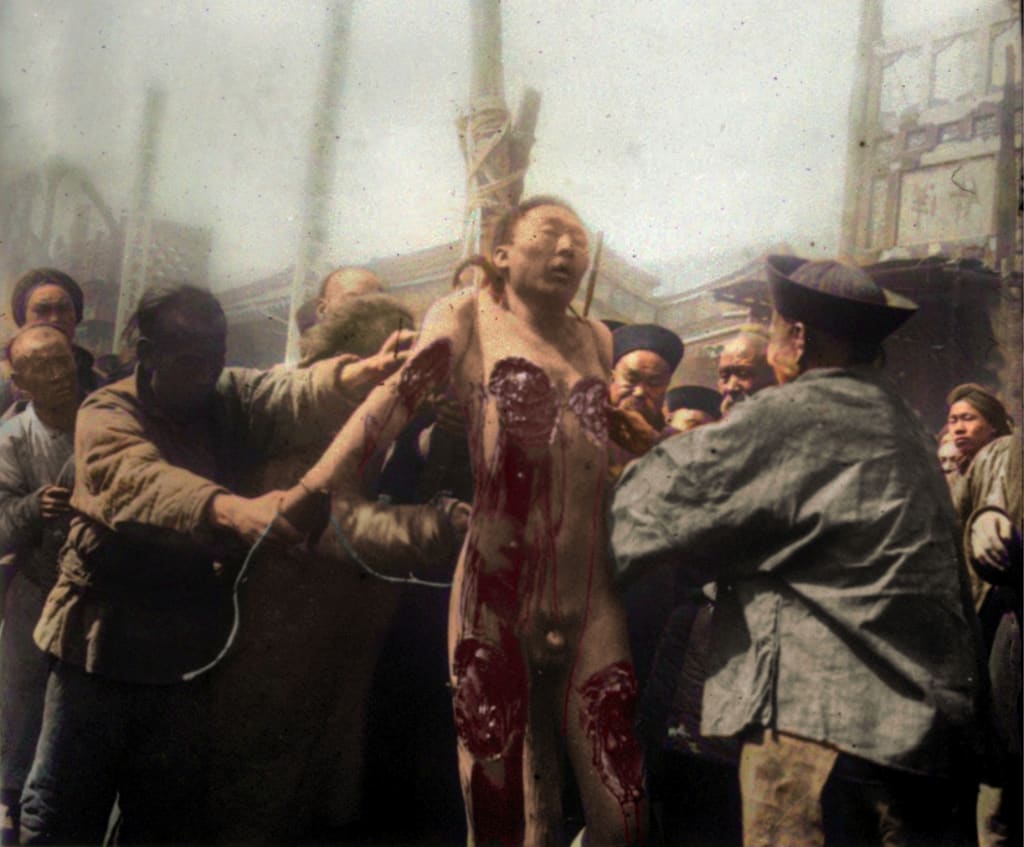THE DEATH BY THOUSAND CUTS
Most disturbing punishment in history

Lingchi, the gruesome practice known as "death by a thousand cuts," holds a chilling place in history. Brace yourself for a bone-chilling journey into the darkest depths of ancient China, where justice took on a macabre and torturous form.
Close your eyes and imagine stepping into a bustling marketplace in 19th-century China. The air is thick with anticipation as whispers of an impending execution circulate through the crowd. Curiosity and dread mingle, painting a vivid tapestry of emotions. People from all walks of life gather, their eyes fixated on the gruesome spectacle about to unfold.
As you inch closer to the center of the commotion, you catch a glimpse of the condemned individual, bound and trembling before a crowd that awaits the horrifying spectacle with a mix of morbid curiosity and morose satisfaction. The condemned person's crimes, whether real or imagined, have condemned them to a fate so gruesome that it sends shivers down the spine.
The authorities, donned in ornate robes, announce the punishment: Lingchi, a punishment designed to inflict the most excruciating pain imaginable. Fear intertwines with fascination, compelling you to witness this macabre theater of justice.
The executioner steps forward, wielding a wickedly sharp blade, poised to commence the dreadful process. The crowd holds its breath, as the first cut is delivered, slicing through the condemned's flesh. A gasp escapes from the onlookers, a chilling symphony of horror.
But this is no swift execution; it is a meticulously choreographed dance of agony. The executioner, adept in his craft, meticulously selects specific points of the body, slicing, gouging, and flaying the flesh with precise strikes. The intention is not to swiftly end the life but to prolong the suffering, to extract the maximum pain possible from the condemned.
With each subsequent cut, the crowd's reactions oscillate between fascination and revulsion. Some turn away, unable to bear witness to the unspeakable cruelty, while others, morbidly captivated, stare transfixed at the grisly scene playing out before them.
The condemned's screams echo through the air, intertwining with the sobs and gasps of the crowd. Every cut deepens the wounds, every drop of blood further saturates the macabre tapestry. The executioner's actions become almost poetic, a dance of death that blurs the lines between pain and artistry.
As the cuts continue to multiply, the condemned's body becomes a grotesque mosaic of suffering. The crowd, now a sea of horrified faces, is caught between despair and a perverse fascination. The air is heavy with an overwhelming mixture of fear and repulsion, an indelible memory etched into the very soul of those who bear witness to such a spectacle.
Hours pass, and the condemned's strength wanes, their once-robust frame now a frail vessel barely clinging to life. Finally, mercifully, the executioner delivers the fatal blow, severing the head from the battered body. Silence descends upon the crowd, broken only by stifled sobs and the sickening thud of the lifeless head hitting the ground.
Lingchi, an unimaginable ordeal of suffering, serves as a harrowing reminder of the depths humanity can sink to in the name of justice. It raises questions about the nature of punishment, the boundaries of cruelty, and the dark corners of the human psyche.
As you turn away from the horrific scene, haunted by what you have witnessed, remember the ghosts of the past. Lingchi, though consigned to history, serves as a chilling testament to the capacity for cruelty that lurks within us all. Its echoes reverberate through time, reminding us of the importance of compassion, empathy, and the pursuit of
About the Creator
leon shahi
Hello there!
How are you ? hope you are fine !
ENJOY WHAT I WRITE ....IT IS FOR YOU !





Comments
There are no comments for this story
Be the first to respond and start the conversation.